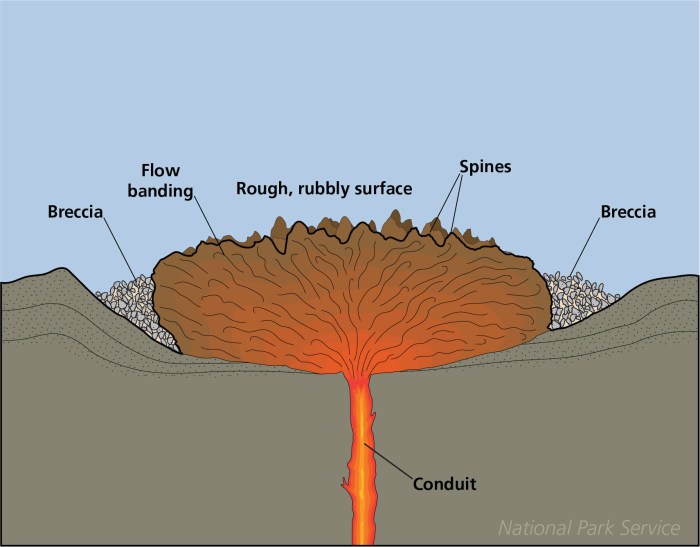Which statements accurately describe volcanic landforms check all that apply – Which statements accurately describe volcanic landforms? Check all that apply. This question delves into the captivating realm of volcanic landforms, inviting us to explore their intriguing characteristics and delve into the processes that shape them. From towering stratovolcanoes to vast lava fields, volcanic landforms stand as testaments to the Earth’s dynamic geological forces.
As we embark on this journey of discovery, we will uncover the secrets held within these enigmatic landscapes, unraveling the stories etched into their very structure.
Volcanic landforms are a testament to the power of nature, showcasing the immense forces that shape our planet. They provide a unique window into the Earth’s geological processes, offering valuable insights into its history and evolution. By studying these landforms, we gain a deeper understanding of the forces that have shaped our planet and the potential hazards they pose to human populations.
Volcanic Landforms and their Formation: Which Statements Accurately Describe Volcanic Landforms Check All That Apply

Volcanic landforms are the result of volcanic eruptions, which occur when molten rock, ash, and gases are expelled from the Earth’s crust. The type of volcanic eruption and the composition of the magma involved play a significant role in determining the shape and characteristics of the resulting landform.Eruptions
can be explosive or effusive. Explosive eruptions occur when highly viscous magma traps gases, causing it to fragment and erupt violently. This type of eruption produces pyroclastic materials, such as ash, lapilli, and bombs. Effusive eruptions, on the other hand, involve the relatively gentle flow of low-viscosity magma.
These eruptions produce lava flows and domes.
Characteristics of Volcanic Landforms
Volcanic landforms are characterized by their distinct physical features. These features include:
Craters
Depressions formed at the summit or on the flanks of a volcano, resulting from explosive eruptions or the collapse of a volcanic cone.
Lava domes
Steep-sided, rounded mounds formed by the accumulation of viscous lava that flows slowly and piles up near the vent.
Lava flows
Streams of molten rock that have flowed out of a volcano and solidified on the surrounding terrain.
Pyroclastic cones
Small, steep-sided hills formed by the accumulation of pyroclastic materials ejected during explosive eruptions.
Volcanic necks
Isolated, steep-sided hills formed by the erosion of surrounding softer material, exposing a core of solidified magma that once filled a volcanic vent.
Classification of Volcanic Landforms
| Landform Name | Type | Key Features |
|---|---|---|
| Cinder cone | Pyroclastic | Small, steep-sided cone composed of cinders and other pyroclastic materials. |
| Lava dome | Effusive | Steep-sided, rounded mound formed by the accumulation of viscous lava. |
| Maar | Phreatomagmatic | Shallow, circular crater formed by a violent explosion when magma interacts with groundwater. |
| Shield volcano | Effusive | Broad, gently sloping volcano with a low profile, formed by the accumulation of low-viscosity lava flows. |
| Stratovolcano | Composite | Cone-shaped volcano with alternating layers of lava flows and pyroclastic materials. |
| Tuff cone | Pyroclastic | Low, broad cone formed by the accumulation of ash and other pyroclastic materials. |
Distribution of Volcanic Landforms
Volcanic landforms are found in various regions around the world, often associated with plate boundaries. The distribution of volcanoes is influenced by factors such as:
Plate tectonics
Volcanoes are commonly found along convergent plate boundaries, where one plate subducts beneath another, causing magma to rise and erupt.
Hotspots
Some volcanoes are located in the middle of tectonic plates, known as hotspots. These volcanoes are formed by plumes of hot material rising from deep within the Earth’s mantle.
Rift zones
Volcanoes can also occur along rift zones, where tectonic plates are pulling apart, allowing magma to rise and erupt.
Impact of Volcanic Landforms on the Environment
Volcanic landforms have both positive and negative impacts on the surrounding environment. Positive impacts include:
Fertile soils
Volcanic ash and lava can weather into fertile soils, supporting vegetation and agriculture.
Mineral resources
Volcanic rocks can contain valuable minerals, such as gold, silver, and copper.
Geothermal energy
The heat generated by volcanic activity can be harnessed for geothermal energy production.Negative impacts include:
Volcanic eruptions
Eruptions can release ash, gases, and lava, causing destruction, displacement, and health hazards.
Lahars
Volcanic eruptions can trigger lahars, which are destructive mudflows composed of volcanic debris and water.
Climate change
Volcanic eruptions can release large amounts of sulfur dioxide and other gases into the atmosphere, potentially contributing to climate change.
Volcanic Landforms as Geological Indicators, Which statements accurately describe volcanic landforms check all that apply
Volcanic landforms can provide valuable insights into past geological events. The composition, texture, and morphology of volcanic rocks can reveal information about:
Magma composition
The chemical composition of volcanic rocks provides clues about the source and evolution of the magma.
Eruption history
The layering and structures of volcanic rocks can reveal the sequence and nature of past eruptions.
Paleoclimate
Volcanic ash and other deposits can contain fossils and other evidence that shed light on past climate conditions.
FAQ Section
What are the different types of volcanic landforms?
Volcanic landforms include stratovolcanoes, shield volcanoes, cinder cones, lava domes, and calderas.
How do volcanic eruptions impact landform creation?
Volcanic eruptions can create new landforms, such as cinder cones and lava domes, and modify existing landforms, such as by filling valleys with lava flows.
What are the key characteristics of volcanic landforms?
Volcanic landforms are typically characterized by their steep slopes, rugged terrain, and the presence of volcanic rocks and minerals.

